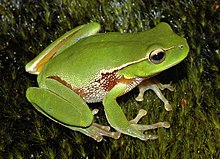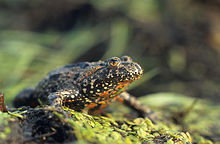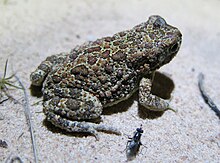Portal:Amphibians
The Amphibian Portal
Amphibians are ectothermic, anamniotic, four-limbed vertebrate animals that constitute the class Amphibia. In its broadest sense, it is a paraphyletic group encompassing all tetrapods, excluding the amniotes (tetrapods with an amniotic membrane, such as modern reptiles, birds, and mammals). All extant (living) amphibians belong to the monophyletic subclass Lissamphibia, with three living orders: Anura (frogs), Urodela (salamanders), and Gymnophiona (caecilians). Evolved to be mostly semiaquatic, amphibians have adapted to inhabit a wide variety of habitats, with most species living in freshwater, wetland or terrestrial ecosystems (such as riparian woodland, fossorial and even arboreal habitats). Their life cycle typically starts out as aquatic larvae with gills known as tadpoles, but some species have developed behavioural adaptations to bypass this.
The young generally undergo metamorphosis from larva with gills to an adult air-breathing form with lungs. Amphibians use their skin as a secondary respiratory surface and some small terrestrial salamanders and frogs lack lungs and rely entirely on their skin. They are superficially similar to reptiles like lizards, but unlike reptiles and other amniotes, require water bodies in which to breed. With their complex reproductive needs and permeable skins, amphibians are often ecological indicators; in recent decades there has been a dramatic decline in amphibian populations for many species around the globe.
The earliest amphibians evolved in the Devonian period from sarcopterygian fish with lungs and bony-limbed fins, features that were helpful in adapting to dry land. They diversified and became ecologically dominant during the Carboniferous and Permian periods, but were later displaced in terrestrial environments by early reptiles and basal synapsids (mammal predecessors). The origin of modern amphibians belonging to Lissamphibia, which first appeared during the Early Triassic, around 250 million years ago, has long been contentious. However the emerging consensus is that they likely originated from temnospondyls, the most diverse group of prehistoric amphibians, during the Permian period. (Full article...)
Selected frog article
Selected salamander article
List of selected salamander articles
|
|---|
Did you know? –

- ... that the Pyrenean brook salamander sometimes lives entirely underground in caves?
- ... that Rhachitomi, a group of temnospondyl amphibians, was established as a clade in 2013?
- ... that the specific name of Tambachia trogallas, the type species of the trematopid temnospondyl Tambachia, refers to the Thuringian bratwurst that was frequently eaten by the describers of the species?
- ... that the female tree frog Aplastodiscus leucopygius inspects the underground nesting chamber prepared by the male before accepting his advances?
- ... that the Italian pool frog (pictured) has been introduced into the United Kingdom?
Selected amphibian type
Toad is a common name for certain frogs, especially of the family Bufonidae, that are characterized by dry, leathery skin, short legs, and large bumps covering the parotoid glands.
A distinction between frogs and toads is not made in scientific taxonomy, but is common in popular culture (folk taxonomy), in which toads are associated with drier, rougher skin and more terrestrial habitats. (Full article...)List of selected amphibian type articles
|
|---|
Selected images
Selected toad article
Selected caecilian article
Rhinatrematidae is a family of caecilians, also known as the Neotropical tailed caecilians, American tailed caecilians. or beaked caecilians. They are found in the equatorial countries of South America.
They are usually regarded as the most basal of the caecilian families, with numerous characteristics lacking in the other groups. For example, they still possess tails, and their mouths are not recessed on the underside of their heads. They lay their eggs in cavities in the soil. The larvae have external gills, and live in seepage areas until they metamorphose. The adults live in moist soil and leaf litter. (Full article...)Need help?
Do you have a question about Amphibians that you can't find the answer to?
Consider asking it at the Wikipedia reference desk.
Topics
Subcategories
Related portals
Associated Wikimedia
The following Wikimedia Foundation sister projects provide more on this subject:
-
Commons
Free media repository -
Wikibooks
Free textbooks and manuals -
Wikidata
Free knowledge base -
Wikinews
Free-content news -
Wikiquote
Collection of quotations -
Wikisource
Free-content library -
Wikiversity
Free learning tools -
Wiktionary
Dictionary and thesaurus











































